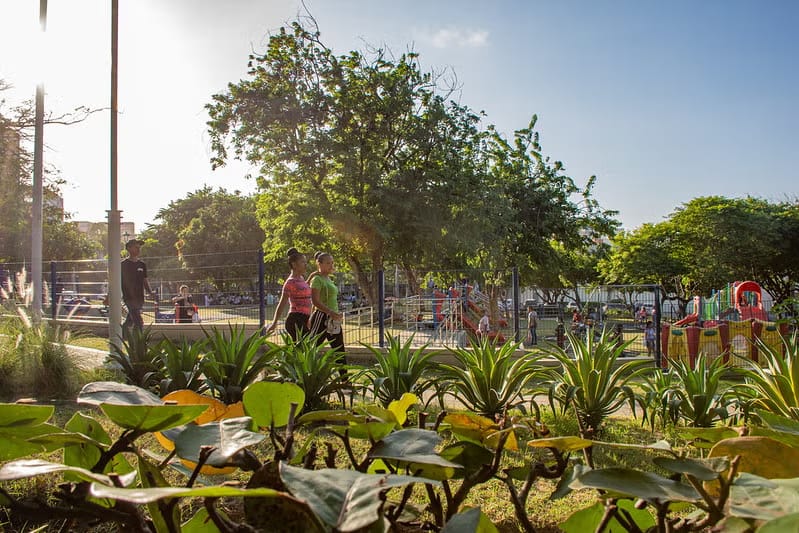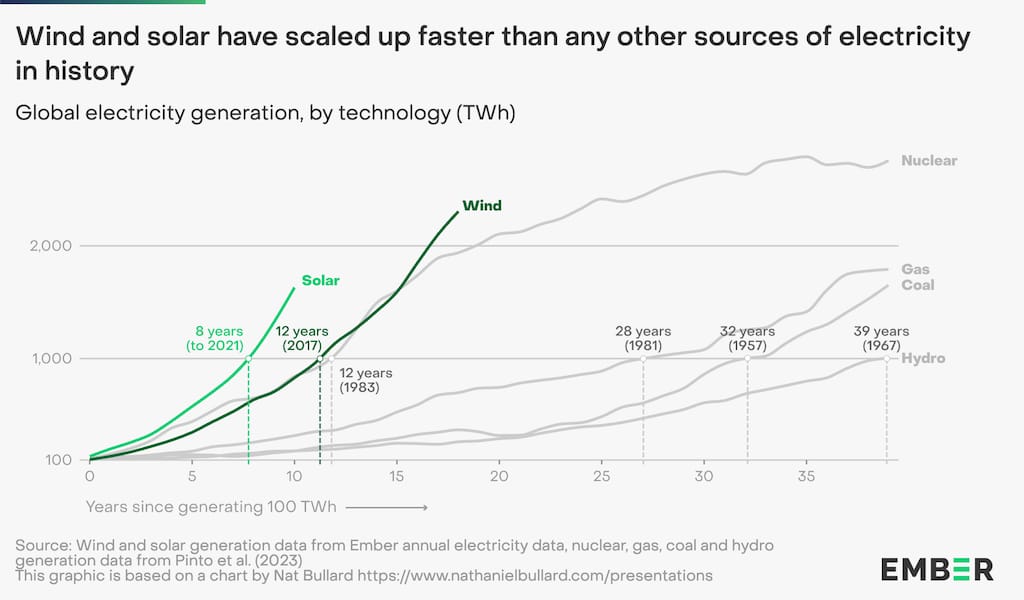- Supercool
- Posts
- 🌐 The ROI on Climate Capital: A Mayor’s Blueprint for Citywide Renewal
🌐 The ROI on Climate Capital: A Mayor’s Blueprint for Citywide Renewal
How nature is delivering economic returns for cities—and the banks financing it.
Converting Skeptics, Building Trust
Many still believe that solving climate change requires sacrifice. Less comfort. Less convenience. Slower growth.
But what if the opposite is true?
What if next-gen climate investments deliver on the things people value most?
🚀 Grow the economy
📈 Raise tax revenue
🤝 Build trust
🌆 Spark civic pride
💡 Improve modern life
That’s exactly what happened in Barranquilla, Colombia’s fourth-largest city. Population: 1.5 million people.

When Jaime Pumarejo first joined the city government in his twenties, Barranquilla was under bankruptcy protection. Poverty was high. Public trust was fractured.
“The city was in a very bad place,” he told me. “It had trust issues. Poverty levels were more than double most major cities in Colombia.”
Jaime had studied at Purdue University and then worked for Ingersoll-Rand in Nashville, Singapore, and finally New Jersey. It was that last stop that convinced him it was time to head back home (no offense, New Jersey).
Over the next decade, Jaime worked on economic revitalization, housing, and mobility. He became the city manager. At every stage, he played a vital role as Barranquilla transformed.
When Pumarejo became mayor in 2020, he accelerated one of Latin America’s most ambitious urban renewal transformations—financing nature, parks, and biodiversity as core infrastructure, with an eye on economic returns.
300 Parks. Built to Last—and Made to Order.
In Barranquilla, parks weren’t expected to last.
“Most parks in Colombia… after a couple of years, it would be like, gone,” Pumarejo said. The swings disappeared. The grass died. People assumed the city would cut the ribbon, walk away, and let it rot.
So when the first new park opened under Jaime’s leadership, a resident was caught digging up a newly planted flower. His reason? “Why not? It’s going to be gone tomorrow.”
But it wasn’t. The city replanted it the next day. And the next. And the next. What started as disbelief turned into pride.
Barranquilla built over 300 parks. Each one was co-designed with the people who lived nearby—what they wanted, how they used space, who they felt it should serve. In one case, children with disabilities requested a boccia court. The city built it. And then the city funded their coach. They won national tournaments.
Each park had a community audit committee during construction and a stewardship group afterward—neighbors helping neighbors, keeping the space clean, safe, and activated.
As life returned to public space, shops and restaurants followed. Parks became economic engines.
“After a couple of years—and I’m talking eight to nine years—the park pays for itself,” Pumarejo said.

A neighborhood park in Barranquilla
Even the city’s wealthiest neighborhoods took notice. One affluent community initially rejected a new park, fearing it would attract outsiders and crime. Five years later, they returned and requested the same quality park they'd once opposed.
Today, 93% of Barranquilla’s population lives within an 8-minute walk of a green space.
Urban Trees as Infrastructure
Trees weren’t an aesthetic choice. They were a financial strategy.
When Pumarejo studied London’s urban forest management, one stat jumped out: tree-lined streets had 15% higher property values.
“That to me was a game changer,” he said. “Because then I said—this is a way I can talk economic sense to the people who don't understand nature.”
The logic was direct: higher property values meant higher tax revenues. That revenue could then be reinvested into neighborhoods, infrastructure, and services. And in a city still recovering from bankruptcy, every peso counted.
He helped launch Siembra Barranquilla, a public-private partnership to scale tree planting across the city. The model included its own nursery, a portfolio of 18 native species, and contractual guarantees to maintain trees after planting—the upkeep wasn’t left to chance.
The benefits compounded:
More canopy meant lower cooling costs for residents.
More shade reduced heat exposure in low-income neighborhoods.
Tree roots slowed runoff and reduced the load on Barranquilla’s billion-peso flood canal system.

Mayor Pumarejo, participating in tree-planting.
The result wasn’t ornamental. It was structural. Trees became part of the city’s climate adaptation, stormwater control, and fiscal recovery plan.
Trust, Wristbands, and the Feedback Loop
Barranquilla wasn’t just bankrupt when Pumarejo entered city government—it was demoralized.
People didn’t expect public works to last. They didn’t expect parks to be maintained. They didn’t expect taxes to result in anything they could see.
So Pumarejo built a feedback loop.
“When you paid your taxes, we would give you a wristband that said, ‘Thank you for believing,’” he said. “Then we would really show you what we did with that money.”
The message was simple: you contribute—we deliver.
Every new park, every planted tree, every upgraded drainage canal sealed that promise. And over time, the city’s expectations changed.
People stopped assuming public goods would fall apart. They started asking for more. Not out of entitlement, but belief.
“Like, wow—these people are really working.”
That trust became leverage. It created political space to invest in long-term projects. And it helped reverse decades of civic detachment—one wristband, and one result, at a time.
In 2022, that transformation earned global recognition. The World Resources Institute awarded Barranquilla the WRI Ross Center Grand Prize for Cities for its Todos al Parque (Everyone to the Park) initiative. Its citywide strategy had expanded green space, restored public trust, and delivered tangible quality-of-life improvements.
Capacity and Constraints
Trust laid the foundation. But fast delivery required more than belief. It took capital and the ability to negotiate on equal footing with international banks.
Barranquilla pulled off something most cities can’t: securing large development loans on municipal terms.
When Pumarejo worked with the French Development Agency (AFD), he negotiated a €170 million loan:
Without a sovereign guarantee
In local currency
Tied to performance metrics—not just project receipts
Delivered directly to the city
That structure gave Barranquilla speed and flexibility—critical for a mayor with a four-year term.
“From the day you say, ‘I want the money’ to the day that you get it, it can be three to four years,” he said. “But a mayor only has four.”
He also convinced the Inter-American Development Bank to restructure a loan midstream, after the projects were already built.
But he’s realistic about what made that possible.
“We are the oddball,” he said. “A lot of cities don't have the capacity or the luck or the confluence of things that happened that permitted it.”
The advantage came from years of internal investment:
A stronger local tax base
Credibility across administrations
Skilled internal teams
Political skills and a mandate to push back
Now, as a member of the SDSN Global Commission for Urban SDG Finance, Jaime is helping other cities close that gap—building capacity, creating bankable plans, and unlocking direct access to climate capital.
Supercool Takeaway
Barranquilla didn’t just rebuild parks. It rebuilt belief.
Jaime Pumarejo made trust visible—on sidewalks, on shaded streets, through playgrounds that didn’t disappear. He turned urban nature into infrastructure, civic pride into public capital, and local capacity into negotiating power.
The city delivered results that people could see. In return, people showed up. They paid taxes. They demanded more. They believed.
That belief became momentum. And that momentum became investable.
Now, Pumarejo is helping other cities do the same—not by copying Barranquilla, but by building their own flywheels of trust, delivery, and capital access.
Because when people trust the system, they invest in it.
And when a city invests back, it doesn’t just transform—it compounds.
Listen to this podcast episode on Apple, Spotify, YouTube, and all other platforms.

↓
Stat of the Week: 8 Years
Solar energy is scaling at a rate faster than any other energy source in history. It took solar just 8 years to grow from 100 to 1,000 terawatt-hours of electricity generation.
For comparison:
Gas: 28 years
Coal: 32 years
Hydro: 39 years
The speed of change is real. The opportunity is massive. The capital is flowing. The challenge? Making sure cities can tap it.

Quote of the Week
Cities can lead the charge on climate by reimagining urban spaces to be greener, healthier, and more sustainable. But to truly transform our cities and meet global climate goals, we need national governments and financial institutions to match our ambitions with real investment.
↓
This Week’s Supercool Sponsor

Built to last. Designed to inspire.
Mill is sleek, sculptural, and capable of exerting 288 lbs of force. Each food recycler is crafted by hand in North America and engineered by leaders from Apple and Nest.
Mill transforms your uneaten food into nutrient-rich food grounds and compost, for use at home and in your community.
Buy, finance, or rent your Mill Food Recycler.
↓
Despite elevated geopolitical tensions and economic uncertainty, the world is on track to surpass $2 trillion in global clean energy investment for the second consecutive year, doubling fossil fuel investment, according to the International Energy Agency.

Global Energy Investment ($ Billions): Clean Energy vs Fossil Fuels - Source: IEA
It’s a staggering number. Proof that the most monumental wave of business innovation in human history is accelerating.
But unlocking capital is only part of the story. Cities still need the tools—and the authority—to put it to work.
That’s where public-private partnerships come in.
In Barranquilla, as discussed above, Mayor Jaime Pumarejo launched a public-private tree partnership with the goal of raising property values, growing tax revenue, and investing in climate resilience. That success helped unlock direct financing from development banks.
In Quito, Mayor Mauricio Rodas led the city’s largest-ever infrastructure project—a metro line funded through a multinational public-private partnership structure. It worked because Quito had the capacity to plan, negotiate, and deliver.
As Rodas put it on the Supercool podcast, “You can’t finance what you can’t structure.”
In Bristol, Mayor Marvin Rees launched City Leap, a $1.6 billion partnership to decarbonize the city’s buildings and infrastructure. However, even with global recognition, Bristol had to develop internal expertise to make it happen.
“We didn’t need more consultants,” Rees said. “We needed to build an in-house team that knew how to design deals, analyze risk, and stand toe-to-toe with the private sector.” You can find the full interview here.
Each city advanced because it didn’t wait for permission. It built the internal muscle to shape partnerships, structure deals, and align private capital with public purpose.
That’s why all three mayors—Pumarejo, Rees, and Rodas—are now part of the SDSN Global Commission for Urban SDG Finance, alongside global champions like Anne Hidalgo of Paris and Eduardo Paes of Rio de Janeiro.
Together, they’re building the new climate finance playbook: How to:
Build capacity
Structure investable projects
Attract capital
$2 trillion is real. Trillions more are necessary. The world’s front-line leaders are ensuring it reaches the cities where returns are strong, and it matters most.
↓
Not yet subscribed to Supercool?
Click the button below for weekly updates on real-world climate solutions that cut carbon, boost the bottom line, and improve modern life.
🌐